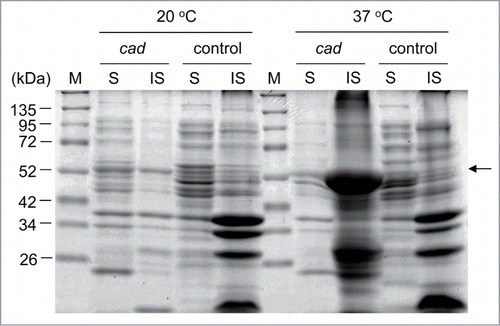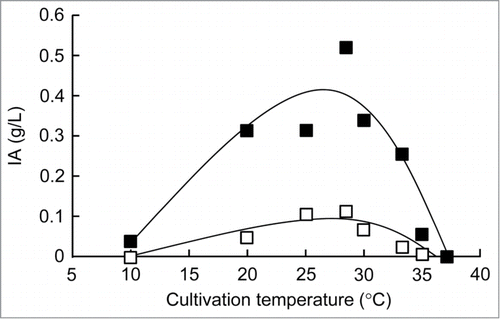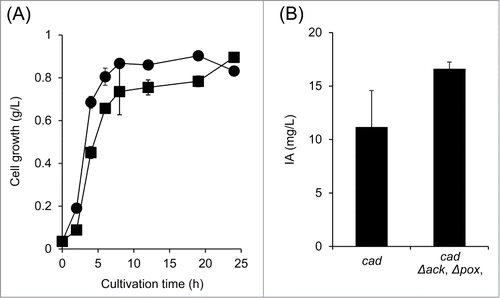Figures & data
Figure 1. SDS-PAGE analysis of the Cad protein in E. coli. E. coli BW25113 (DE3) pLysS harboring pETHis (control) or pETHis-cad (cad) were grown at 20°C or 37°C in 2 mL of LB medium after 0.1 mM IPTG induction. After 18 h of incubation, cells were harvested, disrupted, and separated into soluble (S) and insoluble (IS) fractions. SDS-PAGE analysis was performed on a 12.5% polyacrylamide gel. 10 μg of sample from the soluble and from the insoluble fraction (one-fourth of precipitants) were loaded. The corresponding molecular masses (in kDa) of protein markers (M) are indicated on the left. The expressed Cad protein (54.0 kDa) is indicated by the arrow.

Figure 2. Plot of growth temperature (°C) versus itaconic acid (IA) production (g/L). The overnight cultures of recombinant E. coli (open squares, BW25113 (DE3) (pLysS, pETHis-cad); closed squares, BW25113 (DE3) (Δicd, pLysS, pETHis-cad)) cultivated in LB medium at 37°C were inoculated in fresh 2 mL of LB medium to an OD600 of 0.1. The cultures were subsequently incubated at 10, 20, 25, 28, 30, 33, 35, or 37°C for 18 h. When the cultures reached an OD600 of 0.4–0.6, IPTG was added at a final concentration of 0.1 mM to induce cad expression. The IA production in the resulting strains was analyzed after growth with IPTG induction.

Figure 3. (A) Cell growth and (B) production of itaconic acid (IA) in engineered E. coli. Recombinant E. coli cells (closed circles, BW25113 (pJAK12-cad); closed squares, BW25113 (Δack, Δpox, pJAK12-cad)) grown in LB for 18 h at 37°C,were inoculated in 2 mL of fresh LB medium supplemented with 3% glucose to an OD600 of 0.1. The cultures were subsequently incubated at 28°C for an appropriate time. When the cultures reached an OD600 of 0.4–0.6, IPTG was added at a final concentration of 0.1 mM to induce cad expression. Induction was carried out for 24 h before analyzing the IA production in the resulting strains. Each experiment was performed in duplicates, and the average was represented with error bars indicating standard deviations.

Table 1. Numbers of cells yield (X), itaconic acid (IA) production (P), and specific product yield (YP/X) from engineered E. coli grown for 78 h in different culture mediaa
